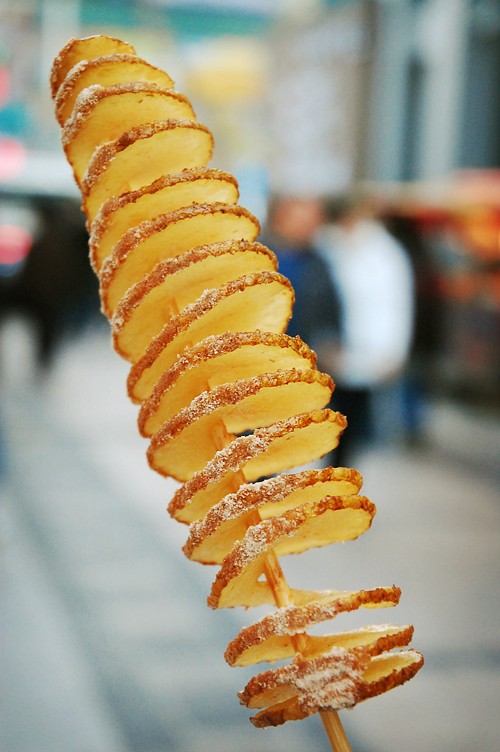A Delightful Guide for Parents about Chips on a Stick
Welcome, dear parents! Today, we’re going to explore the wonderfully fun and delicious world of ‘Chips on a Stick.’ Whether you’re planning a party or just want to offer your children a unique, savory treat, ‘Chips on a Stick’ is your way to go! Keep scrolling for a whirlwind tour of how to make it and why it’s the perfect snack for your little ones.
What is the Exciting Snack – Chips on a Stick?
Before we dive into the process of making it, let’s first understand what ‘Chips on a Stick’ is. For the uninitiated, it’s an extraordinary twist on the classic potato chips. This eye-catching snack is essentially a whole potato intricately spiral-cut into a long coil, spread out to form a “fan”. This “potato fan” is then skewered onto a stick, deep fried to crispy perfection and typically adorned with a variety of seasonings.
Why Your Kids Will Adore Chips on a Stick
A Fascinating and Fun Shape
Kids are visually attracted to their meals, and the unique, spiral form of ‘Chips on a Stick’, which differs greatly from traditional chips, will likely catch their eye immediately. The fun shape alone can make your kids more enthusiastic about snack-time. Plus, there’s something immensely satisfying about eating off a stick— it’s fun, clean, and easy!
Bursting With Flavor
One reason ‘Chips on a Stick’ is so tasty is that the spiral form allows for better distribution of flavor. The evenness of the cut results in even cooking, which ensures that every bite is as crispy and delicious as the last.
An Easy and Enjoyable Process for Making Chips on a Stick
In the next part of this guide, we will tackle everything you need to know to whip up these unique chips. We’ll go through a detailed, step-by-step cooking tutorial along with a list of ingredients and tools you’ll need. Making ‘Chips on a Stick’ can also be a fun bonding activity with your children as you engage them in the preparation process. Stay tuned, dear parents!
Note: Please ensure safety while letting children participate in the cooking session – the use of sharps and hot objects should always be under adult supervision.

Preparing Chips on a Stick – The Magic Lies in the Details
Ingredients:
— Large potatoes (one for each serving)
— Vegetable oil for frying
— Salt or other seasonings as per your preference
— Wooden skewers (make sure they are food-grade)
Equipment:
— A spiral potato cutter. If that’s not readily available, a sharp knife will suffice, but the process will require a little more patience and dexterity.
— A deep fryer or a deep pot with a fry basket
Let’s Get the Chips Spinning!
Step 1: Skewer the Potato
Wash and peel the potato and firmly insert the skewer lengthwise through the center. If you’re using a spiral potato cutter, slide the potato into the device and turn the handle.
Step 2: Cut the Spiral
If you’re going the manual route, carefully start cutting the potato in a spiral form, making sure the thickness is uniform throughout for even cooking.
Step 3: Fry to Perfection
Spread the potato down the skewer to form a “fan”. Heat the oil to around 375°F (190°C) and carefully lower the potato into the hot oil. Fry until golden brown and crispy. This usually takes about 3-5 minutes.
Step 4: Season and Serve
Finally, let it drain on a paper towel, and while still hot, sprinkle generously with your preferred seasonings. Your ‘Chips on a Stick’ are now ready to be served and enjoyed!
Conclusion
And there you have it— a straightforward guide to making ‘Chips on a Stick’, a delightful treat that will charm both you and your little ones with its unique appearance and scrumptious taste. It’s an innovative way to make snack or party time more exciting. From the festive spirals to the crunchy goodness, it proves once and for all that everything is more fun when served on a stick! Happy cooking, parents!
Preparing for Chips on Stick: A Fun Treat for the Little Ones
Preparing chips on stick for your kids is an exciting venture. However, you need a basic understanding of a few things to ensure that you pull it off successfully and in the healthiest way possible. Below are the top 5 things parents should know in preparing for chips on stick.
1. Choosing the Right Potatoes
Choose the right type of potatoes for chips on stick. Larger, starchy potatoes like Russet or Yukon Gold create the best crispy chips. Their high starch content makes them fluffier and crunchier.
2. Correct Cutting Technique
Remember, the chips’ shape is essential for a successful chip on stick. Try not to cut your chips too thin or too thick, as this can affect their crispiness and the time they take to cook.
3. Proper Use of Oil
Do not shy away from oil because chips on stick need an ample amount to achieve that golden and crispy texture. Remember, you’re not soaking them; you’re frying. It’s also critical to heat up the oil first before dropping the chips in.
4. Seasoning
Good seasoning is the secret to making chips on stick that your kids will love. Feel free to experiment with flavors from simple salt and vinegar to more fanciful like garlic, chilli, or cheese powder.
5. Health and Safety Measures
Ensure that everything is done safely, especially when deep frying. Keep your kids at a safe distance to avoid accidents. Remember, moderation is key, and while chips on stick are undeniably tasty treats, they should only be a part of a balanced and nutritious diet.
When prepared the right way, chips on stick can be a fun and delicious treat that your whole family will look forward to. Enjoy the process and savor the delight in your little ones’ eyes as they munch on these appetizing creations!
For more great articles please see here. For more information see here
Disclaimer
The articles available via our website provide general information only and we strongly urge readers to exercise caution and conduct their own thorough research and fact-checking. The information presented should not be taken as absolute truth, and, to the maximum extent permitted by law, we will not be held liable for any inaccuracies or errors in the content. It is essential for individuals to independently verify and validate the information before making any decisions or taking any actions based on the articles.




